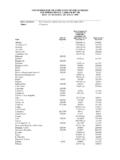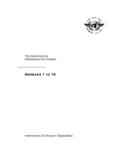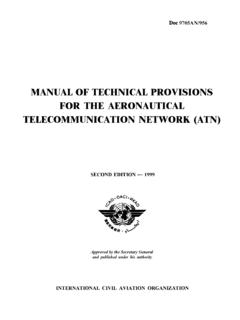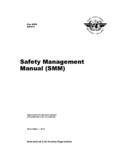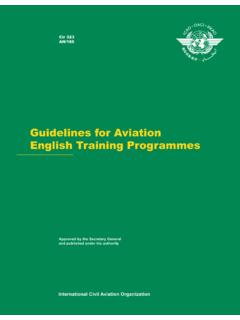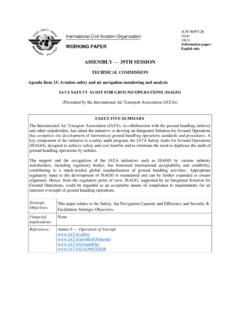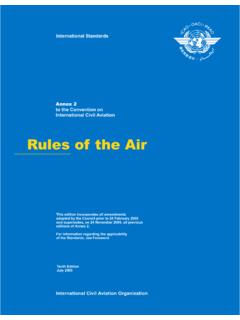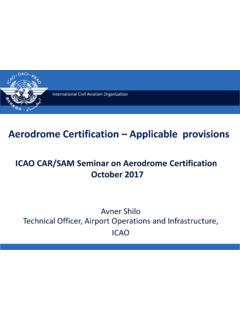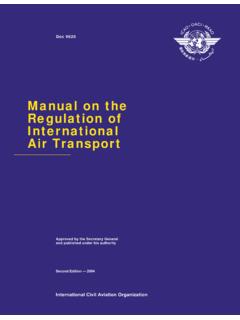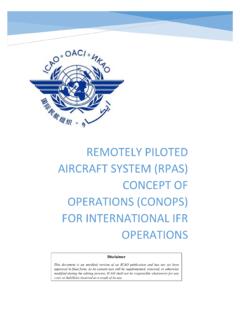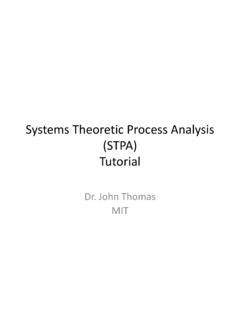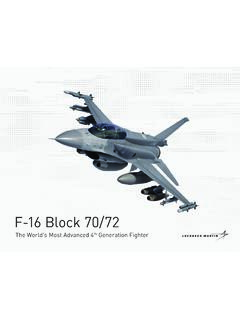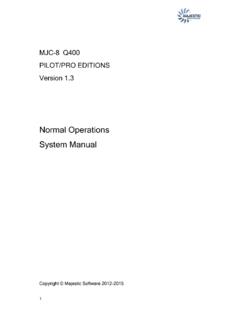Transcription of Airborne Collision Avoidance System (ACAS) Manual
1 International Civil Aviation OrganizationApproved by the Secretary Generaland published under his authorityAirborne CollisionAvoidance System (ACAS) ManualFirst Edition 2006 Doc 9863AN/461 AMENDMENTSThe issue of amendments is announced regularly in the ICAO Journal and in thesupplements to the Catalogue of ICAO Publications and Audio-visual TrainingAids, which holders of this publication should consult. The space below is providedto keep a record of such OF AMENDMENTS AND by(ii) (iii) FOREWORD This Manual has been developed by the Surveillance and Conflict Resolution Systems Panel (SCRSP) (now known as the Aeronautical Surveillance Panel (ASP)).
2 On 2 June 2005, the Air Navigation Commission approved Recommendations 1/2 of the first meeting of the SCRSP relating to the publication of this Manual which is a compendium of information on various technical and operational aspects of the Airborne Collision Avoidance System (ACAS). The material contained in this Manual supplements ACAS Standards and Recommended Practices (SARPs) and procedures contained in Annex 10 Aeronautical Telecommunications, Volume IV Surveillance Radar and Collision Avoidance Systems, Procedures for Air Navigation Services Air Traffic Management (PANS-ATM, Doc 4444) and Procedures for Air Navigation Services Aircraft Operations (PANS-OPS, Doc 8168).
3 Guidance provided in this Manual includes a detailed description of ACAS and associated technical and operational issues in order to facilitate correct operation and operational monitoring, as well as training of personnel. Like other manuals, this document will be amended as and when deemed necessary. In that respect, comments from States and other parties concerned with ACAS would be appreciated. Such comments should be addressed to: The Secretary General International Civil Aviation Organization 999 University Street Montr al, Quebec Canada H3C 5H7 _____ (v) TABLE OF CONTENTS Page Glossary.
4 (ix) Chapter 1. Introduction .. 1-1 Purpose .. 1-1 Scope and 1-1 Objective of ACAS .. 1-2 System overview .. 1-2 Design intention of ACAS II .. 1-3 ACAS I and ACAS III .. 1-5 Chapter 2. Implementation of ACAS .. 2-1 ICAO implementation requirements .. 2-1 2-1 Related 2-3 ACAS manufacturers.
5 2-4 Chapter 3. Functions and capabilities .. 3-1 General .. 3-1 Advisories provided .. 3-1 Intruder characteristics .. 3-2 Control of interference to the electromagnetic 3-5 Factors affecting System performance .. 3-5 System 3-6 3-16 3-29 Receiver and 3-30 Collision Avoidance algorithms .. 3-32 Compatibility with on-board Mode S 3-46 Indications to the flight crew.
6 3-46 Crew control functions .. 3-47 Built-in test equipment .. 3-48 Typical algorithms and parameters for threat detection and generation of 3-48 ACAS II use of hybrid surveillance 3-68 Performance of the Collision Avoidance logic .. 3-70 Indications to the flight crew .. 3-80 Controls .. 3-90 Status and failure annunciations .. 3-91 ACAS limitations .. 3-91 Additional 3-92 (vi) Airborne Collision Avoidance System (ACAS) Manual Page Chapter 4.
7 Relationship between ACAS performance, safety and airspace configuration .. 4-1 Assumptions regarding airspace configuration and operation included in ACAS .. 4-1 Independence of ACAS thresholds from ATC separation standards .. 4-4 Effects of closely-spaced aircraft on ACAS performance .. 4-4 Airspace design 4-4 Chapter 5. Operational use and pilot training 5-1 General .. 5-1 ACAS operational use .. 5-1 Pilot training.
8 5-4 Findings from reviews of existing training 5-15 Examples of problem encounters .. 5-15 Chapter 6. Controller training guidelines .. 6-1 6-1 ACAS training programmes .. 6-1 Recommended content of controller training programmes .. 6-2 Chapter 7. Special uses of ACAS .. 7-1 Military uses of ACAS in formation operations .. 7-1 ACAS installations on rotary wing aircraft .. 7-8 ACAS installations on unmanned aerial vechicles.
9 7-11 Chapter 8. Safety and electromagnetic environmental 8-1 Safety assessment .. 8-1 Electromagnetic environment 8-4 Chapter 9. ACAS performance 9-1 Need for ACAS monitoring programmes .. 9-1 Monitoring programme objectives .. 9-1 Description of current monitoring programmes data sources .. 9-2 Methods of data 9-3 Products of monitoring and analyses programmes.
10 9-3 Harmonization of monitoring data .. 9-4 Recommended ACAS problem review process .. 9-4 Table of Contents (vii) Page Chapter 10. ACAS-related transponder performance 10-1 Need for transponder monitoring programmes .. 10-1 Transponder issues and their impact on ACAS .. 10-1 Alimetry data quality .. 10-5 ACAS and transponder test equipment .. 10-6 Chapter 11. Certification and operational 11-1 Basis for existing equipment and installation certification.
